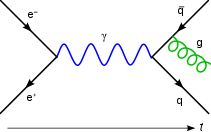
Back كسر التناظر التلقائي Arabic Спонтанно нарушение на симетрията Bulgarian Trencament espontani de simetria Catalan Spontánní narušení symetrie Czech Spontane Symmetriebrechung German Ruptura espontánea de simetría Spanish Simetriaren haustura espontaneo EU خودبهخود شکستن تقارن FA Brisure spontanée de symétrie French Briseadh spontáineach siméadrachta GA

| Quantum field theory |
|---|
 |
| History |
| Statistical mechanics |
|---|
 |
Spontaneous symmetry breaking is a spontaneous process of symmetry breaking, by which a physical system in a symmetric state spontaneously ends up in an asymmetric state.[1][2][3] In particular, it can describe systems where the equations of motion or the Lagrangian obey symmetries, but the lowest-energy vacuum solutions do not exhibit that same symmetry. When the system goes to one of those vacuum solutions, the symmetry is broken for perturbations around that vacuum even though the entire Lagrangian retains that symmetry.
- ^ Miransky, Vladimir A. (1993). Dynamical Symmetry Breaking in Quantum Field Theories. World Scientific. p. 15. ISBN 9810215584.
- ^ Arodz, Henryk; Dziarmaga, Jacek; Zurek, Wojciech Hubert, eds. (30 November 2003). Patterns of Symmetry Breaking. Springer. p. 141. ISBN 9781402017452.
- ^ Cornell, James, ed. (21 November 1991). Bubbles, Voids and Bumps in Time: The New Cosmology. Cambridge University Press. p. 125. ISBN 9780521426732.